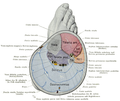| Fascial compartments of leg | |
|---|---|
 Cross-section through middle of leg. Four compartments painted in different colors. | |
 Muscles of the lower leg. Four compartments painted in different colors. | |
| Anatomical terminology |
The fascial compartments of the leg are the four fascial compartments that separate and contain the muscles of the lower leg (from the knee to the ankle). The compartments are divided by septa formed from the fascia. The compartments usually have nerve and blood supplies separate from their neighbours. All of the muscles within a compartment will generally be supplied by the same nerve.





